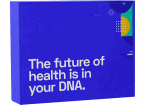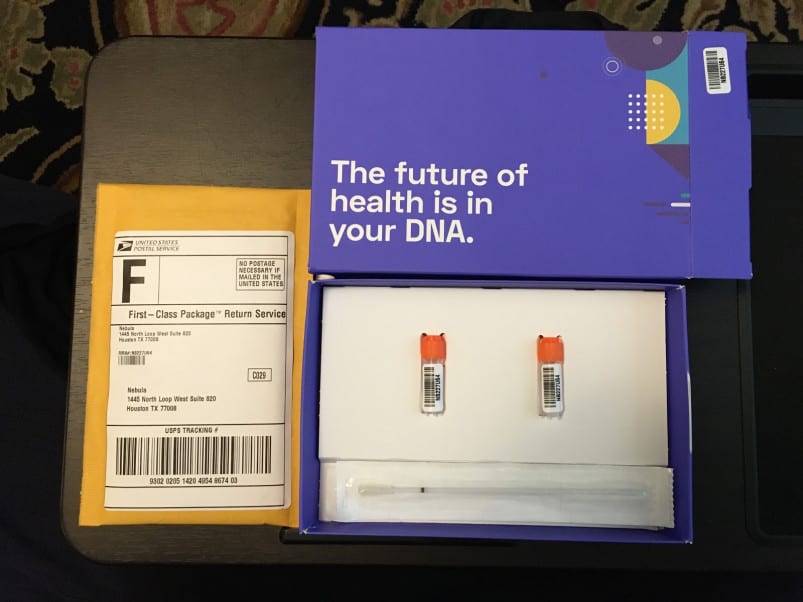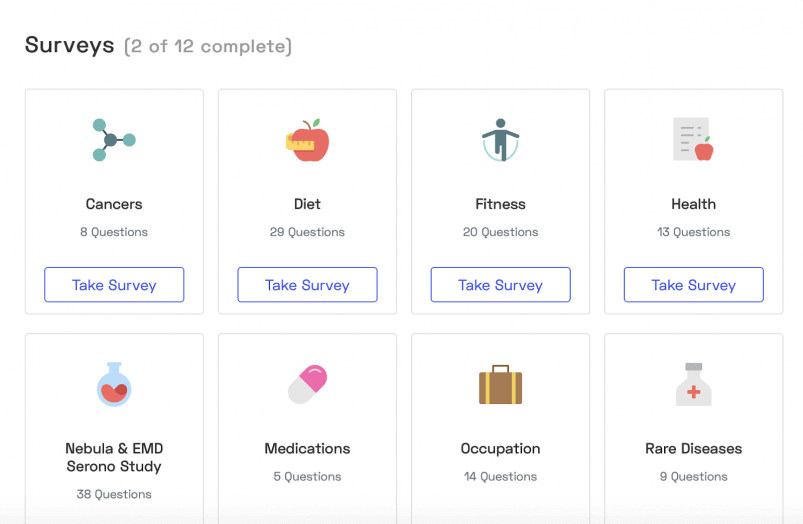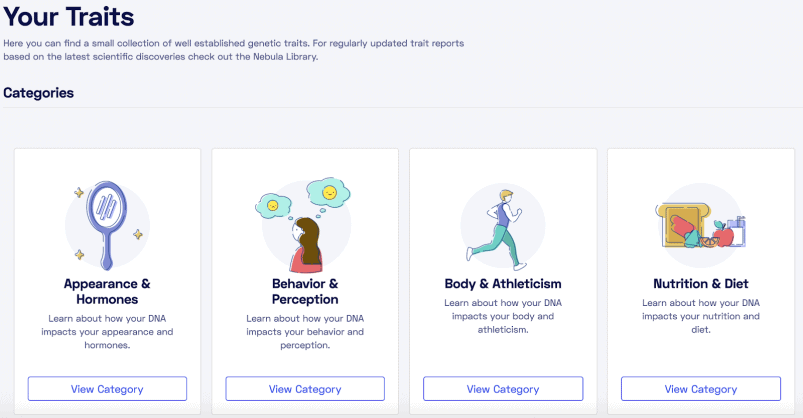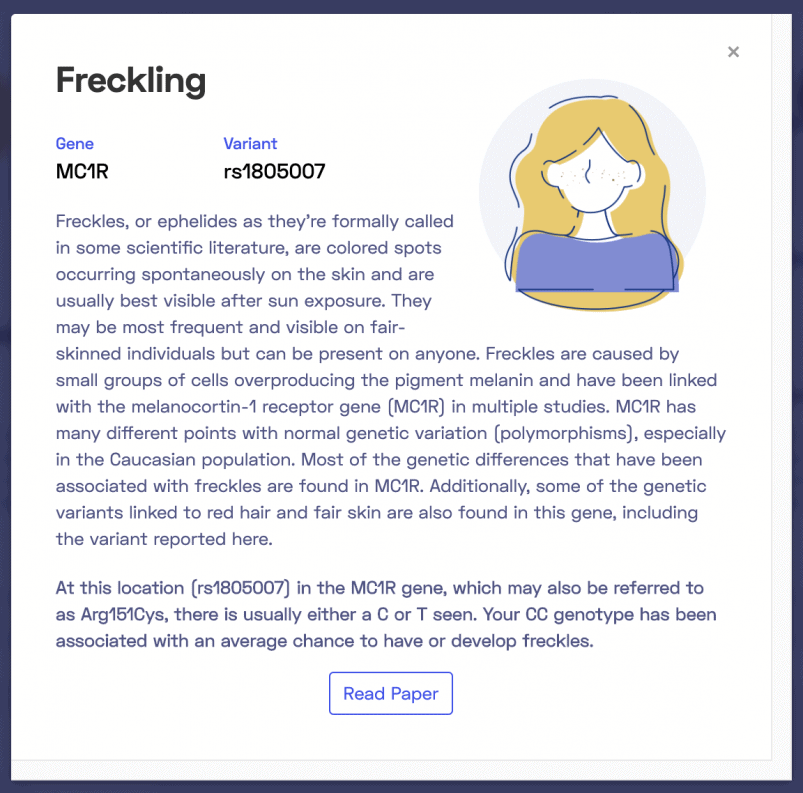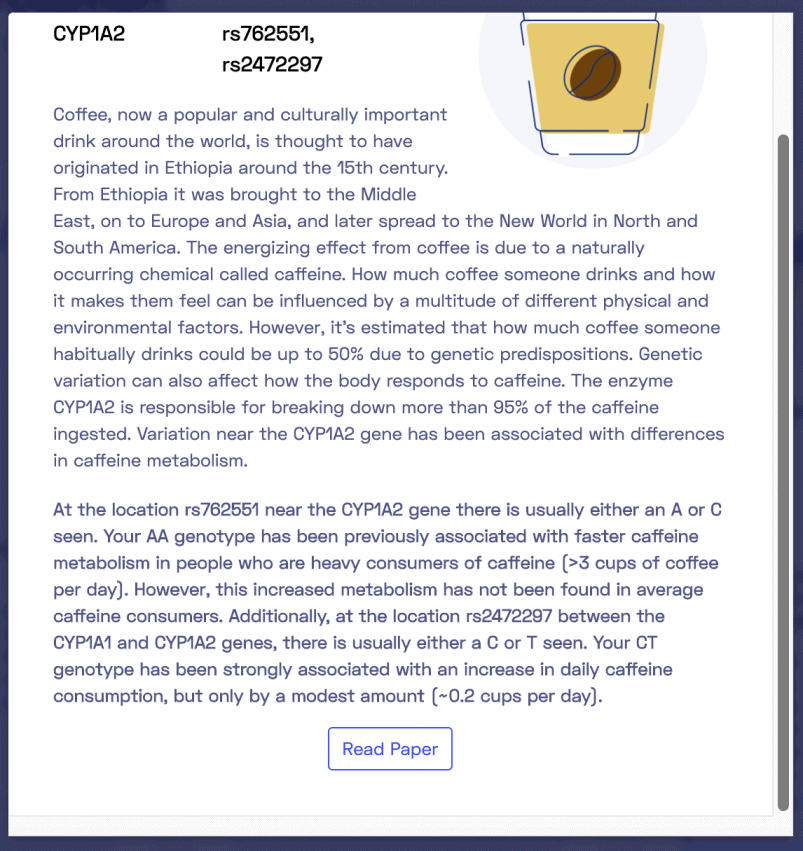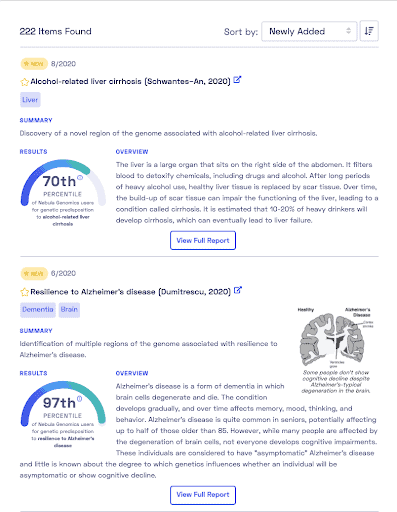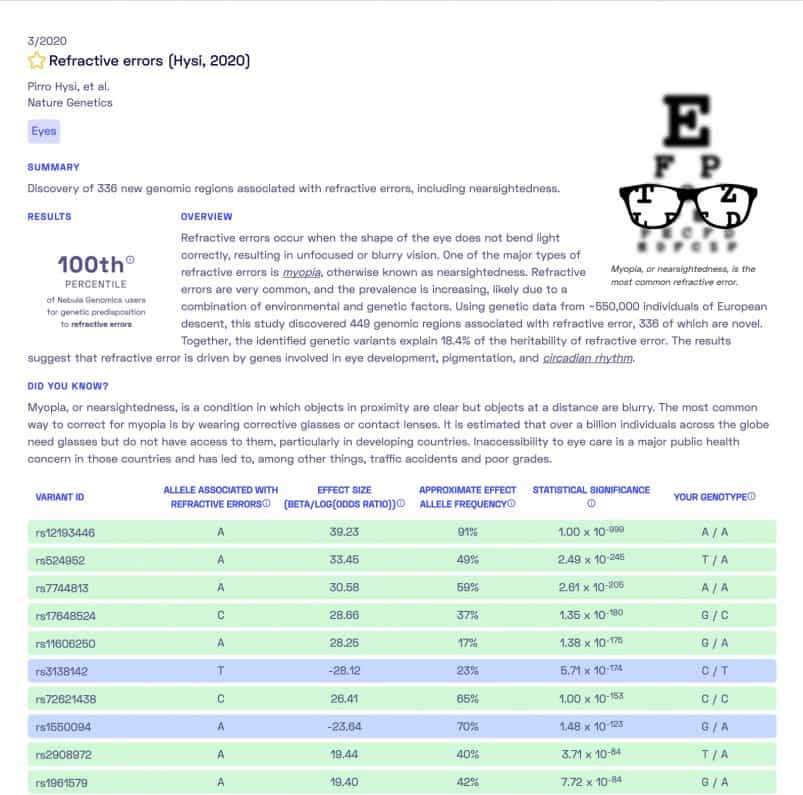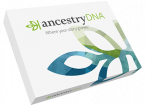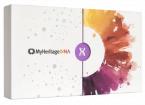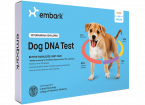Nebula Genomics Overview: Does 30x Whole Genome Sequencing Really Make a Difference?
In 2018, Nebula Genomics emerged as a significant player in the DNA testing industry by offering both ancestry and health insights. The company has recently enhanced its services by introducing 30x whole-genome sequencing, providing a far more detailed and thorough analysis of an individual’s DNA.
While most DNA testing services focus on analyzing just about 2% of the genome by targeting specific markers, Nebula Genomics takes a different approach by sequencing all 6.4 billion base pairs of your DNA—and doing so 30 times. This high level of depth and repetition ensures a superior degree of accuracy and precision in their results, making Nebula Genomics stand out in the industry for its comprehensive testing capabilities.
Having experimented with numerous DNA tests myself, I was keen to see how Nebula Genomics compared. My goal was to assess whether its distinctive approach truly offers a superior and more insightful testing experience.
Is Nebula Genomics the top pick for your DNA testing needs? Continue reading to uncover the results of my analysis.
Get Started With Nebula Genomics
How Nebula Genomics Works
As I said, I’ve taken a lot of genetic tests by now, so I’m very used to collecting and mailing in samples of my DNA. In this respect, Nebula Genomics is exactly like most other companies.
- Your kit arrives in the mail. You go onto the company’s website and create a profile, including the serial numbers printed on your sample vials. You can also answer some quizzes about your family health history, what medicines you’re taking, etc.
- You wait an hour after eating or drinking anything. Then you rub one swab against the inside of one cheek for 45 seconds, put the head of the swab into a sample vial, and screw the vial shut. Then you do the same thing with the other swab on the other cheek.
- Put both sample vials in the plastic pouch, put that in the postage-paid return envelope, and mail it.
After that, you wait 8-10 weeks. (In my case it was 13.) Nebula Genomics will email you when your results are ready, and you log onto the company’s website to view your report.
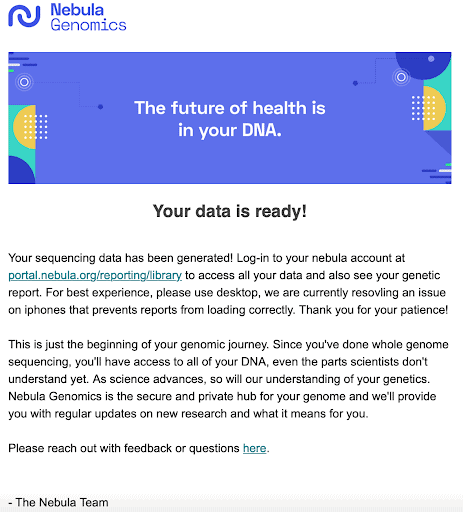
I’ll show you my report a little later.
Start Your Journey With Nebula Genomics!
4 Standout Features of Nebula Genomics
1. 30x Whole Genome Sequencing
This is a sequencing method that provides a comprehensive analysis of your genetic makeup and covers both coding and non-coding regions. It uses Illumina technology and sequences a small saliva sample to provide high-depth coverage and accurate results. Since it sequences your entire genome 30 times, it can detect ancestry informative markers and help you identify more distant and admixed ancestry.
2. Data Privacy
Nebula Genomics protects your genomic data by using advanced encryption and secure cloud storage. It also gives you control over how your data is used and the ability to revoke access or delete it entirely. This ensures peace of mind as you won’t have to worry about potential misuse or mishandling of sensitive genetic information.
3. Traits Report
The Traits Report analyzes your genetic information to determine physical and behavioral traits, using the latest scientific research. This report is regularly updated to maintain accuracy and relevance.
Gaining insight into these traits can offer meaningful perspectives on your personal identity, potentially shaping choices in relationships and career paths. Moreover, physical traits like height and eye color can reveal connections to your ancestry and family history, deepening your appreciation of your genetic background.
4. The Nebula Research Library
The Nebula Research Library provides personalized genetic reports to deepen your understanding of your ancestry. It gathers data from more than 150 genome-wide association studies, equipping you with resources to investigate your genetic history. The library enables you to examine specifics like your polygenic score and percentile rankings, investigate specific genetic variations, and follow the migration routes of your ancestors.
Get Gold Standard DNA Testing With Nebula Genomics!
Was It Worth the 13-Week Wait?
When I sent Nebula Genomics my gene sample, I didn’t know what to expect. Among other things, I was under the impression that the company was going to give me a report on my ancestry…but that wasn’t the case. (Ancestry is “coming soon,” Nebula says.)
It took me 13 weeks to receive my report. Granted, the company’s processing may have been delayed by the COVID-19 pandemic…like everything else.
Traits report
What I did get as part of my Nebula Genomics results was a report on my inherited traits — broken into these categories:
- Appearance & Hormones
- Behavior & Perception
- Body & Athleticism
- Nutrition & Diet
(In addition to Traits, there are several other sections of my report that I’ll get to later.)
For each Traits category, there are a number of traits you can explore. Here are Nebula’s findings for me in the Appearance & Hormones section:
- Earwax Type (“You likely have wet earwax”) (Yuck)
- Freckling (“You have an average chance to have or develop freckles”)
- Hair Thickness (“You likely have average hair thickness”)
- Testosterone (“You most likely have average serum testosterone levels”)
By the way, the items that Nebula includes in this category are very selective, don’t you think? Why include just one hormone? Why not include other physical traits like hair, skin, and eye color?
By way of comparison, in this category. Interestingly, 23andMe’s report concurs with Nebula Genomics about my earwax type and freckling.
Here is what my Freckling report from Nebula says:
And for the record, it’s true that I don’t have much in the way of freckles. The ones I do have are all concentrated on my left shoulder. Go figure.
The Behavior & Perception section of the traits report covers:
- Alcohol Sensitivity (I have “average sensitivity”)
- Asparagus Metabolite Odor (I have “average odds” of being able to smell asparagus in urine. Do I care?)
- Caffeine Use (I’m likely to metabolize caffeine faster than most people)
- Cilantro (Coriander) Preference (I’m likely to dislike cilantro)
- Misophonia (dislike of specific sounds, like chewing noises or heavy breathing) (I’m not likely to have it)
- Nicotine Response (I’m at increased risk of becoming addicted to nicotine. Good thing I don’t smoke)
- Pain Sensitivity (I’m average)
- Snacking Behavior (also average)
Like many other DNA tests, Nebula Genomics’ test found that I’m likely to drink more caffeine than most people. Every other DNA test I’ve taken has said the same thing. Guilty as charged.
Also, yes, I can smell asparagus in pee. I don’t care for cilantro. And Nebula’s findings concerning these traits concur with other tests I’ve taken.
This would be a good time to point out that Nebula Genomics, 23andMe, and Vitagene (just for example) all based their conclusions about my caffeine consumption on the same data: on gene CYP1A2, under the single nucleotide polymorphism (SNP) rs762551, my genotype is AA, which is associated with faster caffeine metabolism.
Additionally, 23andMe looked at a second gene, AHR, which contains instructions for a protein that ramps up production of the CYP1A2 enzyme.
Nebula Genomics also looked at SNP rs2472297, which is located between the CYP1A1 and CYP1A2 genes. They say my CT genotype is strongly associated with increased daily caffeine consumption, but only by a modest amount (~0.2 cups per day).
So — all three companies based their conclusion about my caffeine consumption on slightly different factors. But they all reached the same conclusion.
In my opinion, Nebula, with its whole genomics approach, did not come up with a more meaningful and accurate conclusion about this trait than the other two companies.
My results in the Body & Athleticism category:
- Blood Pressure (I have “an average risk of high blood pressure”)
- Height (I’m more likely than average to be tall)
- Jimmy Legs (i.e. restless legs syndrome) (I’m at increased risk)
- Longevity (I’m likely to be average)
- Muscle Strength (I’m likely to be average)
- Muscle Volume (I’m likely to be average)
- Nearsightedness (I’m “slightly” more likely to be nearsighted)
- Obesity (I’m at average risk)
- Physical Conditioning (I’m likely to have increased responsiveness to physical training)
- Skin Sensitivity (I’m likely to be more sensitive to sunlight than most people)
- Sleep Depth (I’m likely to experience an average depth of sleep)
How do these findings compare to reality? My blood pressure is always nice and low. I’m 5’ 11”. I’m extremely nearsighted (and also very myopic). I sunburn pretty easily, and I sleep very deeply but am prone to middle-of-the-night insomnia.
Incidentally, 23andMe found that I’m less likely to be a deep sleeper, more likely to be overweight, and am likely to have average or less-than-average movement during sleep.
So, there was some disagreement about these traits, and I don’t know which company’s methodology was more sound than the other’s.
Let’s look at obesity.
- Nebula Genomics says I’m at average risk, based on genes ADRB2 and ADIPOQ, SNPs rs1042714 and rs17300539.
- Vitagene says I’m at increased risk of obesity, based particularly on gene BDNF, SNP rs2030323, and SNP rs633715, which is “intergenic”.
- 23andMe also says I’m at increased risk — based on a composite score that weighs a lot of different factors. The company doesn’t say what specific genes and SNPs they considered.
So: Who’s right? Whose methodology is best? I don’t know. But I’m not overweight, for what it’s worth.
Lastly, the Nutrition & Diet part of Nebula Genomics’ report discusses…
- Hunger Response (I’m likely to be average)
- Lactose Intolerance (I’m likely to be able to digest lactose)
- Sweet Tooth (I’m likely to consume an average amount of sugar)
- Vitamin B12 (I’m likely to be deficient)
- Vitamin C (I’m not likely to be deficient)
- Vitamin D (I’m likely to be deficient)
Every DNA test I’ve taken agrees that I’m unlikely to be lactose intolerant (and I’m not lactose intolerant, for the record). They’ve also all agreed that I’m likely to be deficient in vitamins B12 and D.
Anyway, aside from this report on my inherited traits, what else is included in my Nebula Genomics DNA report? After all — the company sequenced my whole genome. What else did it find? What are the implications for me?
Start Your Journey With Nebula Genomics!
Nebula Library
This section of my genetics report is “a curated repository of research publications and genomic discoveries! Check back regularly to find new publications and how they relate to your genomic data!” Inside the library, you can read little gems like this:
Now, I’m not a geneticist, but I am slightly more educated about genetics than most people. And I can barely bring myself to read any of these articles. Even though they’re about me, like this one on visual refractive errors (I have a ridiculous amount of myopia).
The article looks at literally hundreds of gene variants that have been associated with refractive errors, points out which of these variants I have, and indicates how significant the correlation with myopia is.
If I had hours and hours, I’m sure I could find a lot of articles like this that could help me learn things about myself and my genetic traits. But I don’t have that much time, and I doubt many of you do, either.
Gene Analysis
The Gene Analysis section of my Nebula Genomics report is powered by gene.iobio. “This gene analysis tool enables you to examine any gene in your genome and identify variants that may have a clinical significance,” it says.
“To get started, enter a gene name (e.g. BRCA2) into the search field in the navigation bar. In the panel on the left, you will then see a list of all genes that you searched for during a session. Click on a gene to examine it.”
Well, that’s cool. If I had a catalog of gene names in my head, I could look up all the ones that I know are meaningful and see what gene variants I have.
But, do I have a catalog of gene names in my head? No. I do not.
So I decided to search for FTO, a gene mentioned in my Vitagene report. Vitagene says that at SNP1421085 my genotype is CC, which has a fair degree of association with stress eating.
Here’s what I found at gene.iobio:
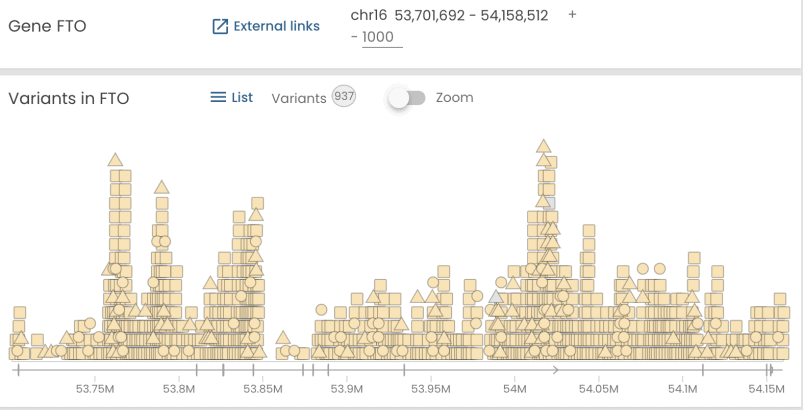
If I click on any of those circles, squares, or triangles, it tells me what SNP that is. But how do I find SNP 1421085? I can’t figure it out for the life of me.
But in my defense, when I buy a DNA test, I expect the testing company to interpret my genes for me. Because I don’t know how to read this stuff. Do you?
Genome Browser
In this part of my report, I can get a detailed look at each of my chromosomes. For example, here’s my X chromosome:

The page says “Zoom in to see features.” When I do that, I can see two parallel blue-and-white-striped lines that represent the two strands that make up that chromosome’s double helix. And if I click on one of the lines, I get to see what I’m looking at.
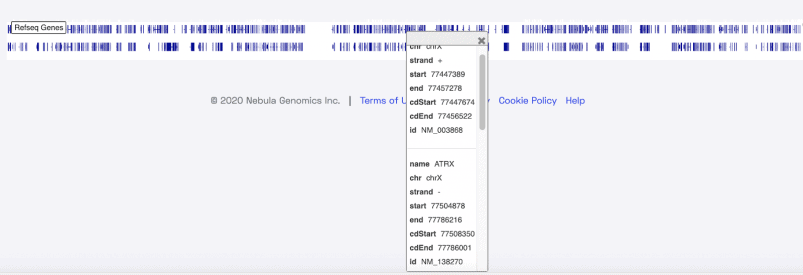
Apparently, I’m looking at genes FGF16 and ATRX, and there’s lots of data about where they start and stop on the X chromosome, which strand they’re located on, and some other stuff that I can’t even interpret. Fascinating…if I knew what FGF16 and ATRX do.
I could look it up, but it would be nice if the Genome Browser would tell me. It would also be nice if it told me what SNPs are involved, what genotypes I have, and what that says about me.
But people have an awful lot of genes, have you noticed? I could study my genome forever if I had the patience, and had any idea what I was looking at.
But I don’t.
Next, I once again searched for the gene FTO.

Apparently, it’s located on chromosome 16 at positions 53, 703,156-54,122 and 941. Good to know! Can I locate SNP 1421085 somehow? I tried zooming in…
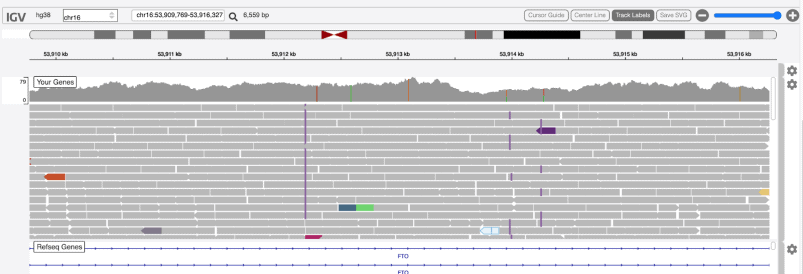
I have literally no idea what I’m looking at or how to interpret it.
So, to summarize…
My Nebula Genomics report contains four sections: Traits, Library, Gene Analysis, and Genome Browser.
The Traits section isn’t terribly impressive. It doesn’t tell me anything I haven’t read in my other DNA reports, and where it disagrees with their conclusions, I don’t know whether I should believe Nebula Genomics’ findings over what the other reports said.
As for the Library, Gene Analysis, and Genome Browser sections…I almost feel like I would need to be a geneticist in order to understand the information they contain and what it means for me.
Do I feel like I got my money’s worth? Keep reading.
What’s the Catch? The Mandatory Subscription!
At face value, Nebula Genomics’ DNA test costs 637,00 $US. That’s a fair bit higher than comparable DNA tests from () or AncestryDNA(99,00 $US).
However, when you buy your test, you’re also automatically enrolled in the Nebula Explore™ Plan, a paid subscription service that promises you “multiple new reports every week, unlimited use of genome exploration tools, and premium support provided by geneticists.”
That’ll set you back $19.99 each month if you pay monthly (basically $240 a year), or $119.88 if you pay for a year at a time. Or you can get unlimited lifetime access for $300.
When you buy your kit, by default you’re charged $300 for unlimited lifetime access, so your total comes to $599.00. You have to actively select one of the other subscription plans in order to pay less.
The only way to have no subscription costs is to cancel your subscription after the fact. And if you do, you’ll lose access to all your Nebula Genomics reports! (You retain access to your genomic data, and you can download it anytime.)
To me, this is the fishiest thing about Nebula Genomics. With pretty much all other DNA companies, once you’ve paid for your test, you can continue to access your reports online forever, with no restrictions. With this one, that’ll cost you extra.
Nebula explains the mandatory subscription service by saying that the reports it gives you are dynamic and evolving, so you could theoretically find out new information about yourself every month.
If you’re not interested in paying for that privilege, you could just pay $19.99 for one month and then cancel after you’ve looked at your whole report. Or, you could download your genetic data in various formats — CRAM, CRAI, FASTQ, VCF, or TBI — whatever those are. But then what do you do with the data?
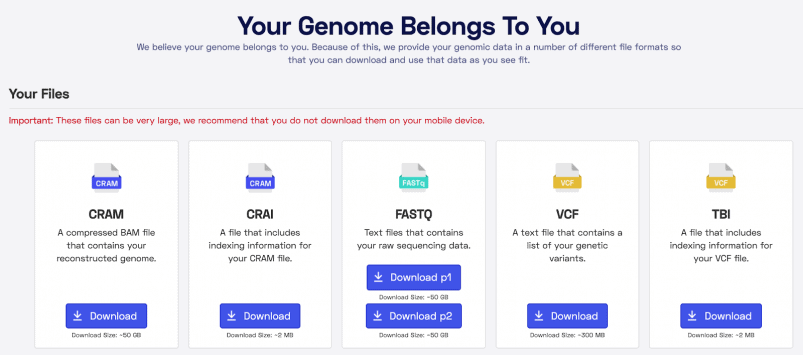
Still, when this company claims that it’s brought the cost of whole-genome sequencing to (just) below the $300 mark, and then it charges you basically double that so you can retain lifetime access to your reports, that’s a huge bait and switch in my book. And it puts Nebula Genomics in the same price ballpark as its competitors in the 30x whole genome sequencing arena.
But if you put aside that mandatory subscription, my other issue with the pricing of this DNA test is that it didn’t give me much information I can understand.
The Traits part of my DNA report is straightforward and accessible…but for less money, 23andMe gave me similar information and also told me all about my ancestry, my genetic health risks, my likelihood of being a carrier of various hereditary diseases, and a lot more.
The Library, Gene Analysis, and Genome Browser sections of my Nebula report give me a lot of additional information — but to me, it’s so esoteric that trying to go through it just makes me feel stupid.
If I was an actual geneticist, these sections might make me giddy with excitement. But I’m not.
Nebula Genomics accepts Discover, Visa, MasterCard, and American Express cards “and more.”
Explore Your DNA With Nebula Genomics!
The Answers I Received Were Quick and Clear…But Not Enlightening
In writing this review, I had a couple of questions that I couldn’t easily find answers to on the Nebula Genomics website (including on the company’s FAQ page or its blog) — or anywhere else.
So I submitted this inquiry via the website’s contact form (which seems to be the only way of reaching Nebula Genomics to ask a question):
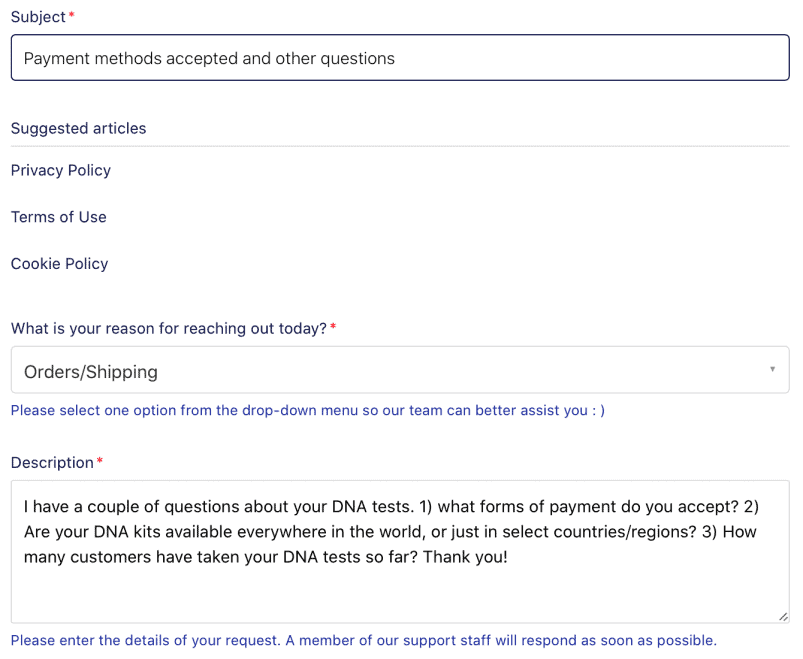
Here’s the answer I received via email about an hour later (which is pretty quick as such things go):

(I love it when companies call me “Stern”! LOL)
Seriously, this is a pretty clear and honest answer. But if the company has been doing DNA testing since 2018, it should have at least some record of how many customers it has tested.
Then the email continues with a lengthy sales pitch (5 paragraphs) explaining why 30x Whole Genome Sequencing is so much better than other commercially available DNA testing methods.
In my next contact request, I asked how many geographic regions Nebula Genomics divides the world into when estimating your ethnicity. For instance, MyHeritage DNA only recognizes 42 distinct regions; 23andMe recognizes more than 1500. The more distinct world populations a DNA company compares your samples to, the more accurately it should be able to pinpoint the ethnicities you have in your background.
The reply:

Setting aside for the moment that ancestry isn’t even part of my Nebula Genomics DNA report yet (“Deep Ancestry” is “Coming Soon,” according to the company’s website)…I’ve taken the Family Tree DNA ancestry test, and I wasn’t impressed!
Family Tree DNA uses 24 global “population clusters” to determine your ethnicities. See the list below.
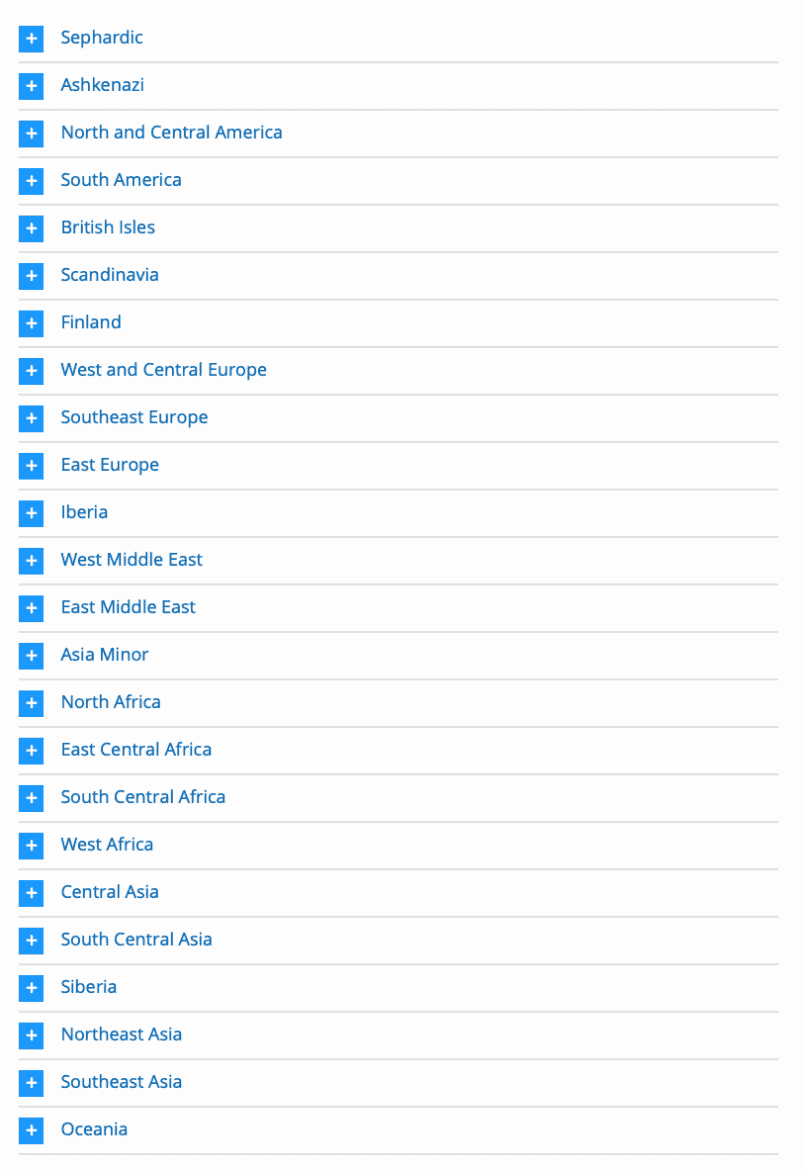
You might think that by clicking on each plus sign, you would see the population cluster broken down into smaller components. But no. You just get a description of how that cluster is defined.
For example, “The Northeast Asia cluster encompasses present-day China, Mongolia, Japan, Korea, Siberia, and Kazakhstan.” But do you realize how genetically and ethnically diverse the populations in that region are?
Sigh.
Great If You’re a Trained Geneticist. Unimpressive Otherwise.
After charging you a staggering price, Nebula Genomics doesn’t deliver much information that a person like me can understand. The Traits section was the only part that spelled out for me how my genetic heritage may affect who I am today.
But in that regard, I felt I got a lot more insights and value out of my DNA tests from 23andMe, MyHeritage DNA, AncestryDNA, and Vitagene, to name a few.
As for the Library, Gene Analysis, and Genome Browser sections of my Nebula Genomics DNA report, they would probably be of enormous interest to someone who can understand and appreciate them. But that’s not me.
Frequently Asked Questions
Does Nebula Genomics do genome sequencing for free?
A few years ago, Nebula Genomics would let anyone take its DNA test at no charge — in exchange for answering a number of health questions, and then allowing the company to share customers’ DNA information with genetic researchers.
But that’s no longer the case. Currently, a test from Nebula Genomics costs 637,00 $US — plus an ongoing subscription fee.
However, if you’ve already had your DNA tested by either 23andMe or AncestryDNA, you can download your raw data from those companies, upload it to the Nebula Genomics website, and then receive a free DNA report.
This report is probably not equivalent in scope to the report you’d get from using Nebula Genomics for your test. Most likely it’s just intended to give you a taste of what you’d get from a paid Nebula Genomics report and subscription.
Customers who’ve already bought and registered a Nebula Genomics test kit aren’t able to upload their raw data from 23andMe or AncestryDNA.
Are there any other companies that do whole genome sequencing?
Yes. In fact, there are a few other companies that now offer 30x whole genome sequencing, just like Nebula Genomics — notably Dante Labs and Veritas Genetics. Their DNA test kits start at $599…which is exactly what you’d pay to get a Nebula Genomics test plus a lifetime subscription.
Does Nebula Genomics share my information with third parties?
The only third parties with which Nebula Genomics ever shares people’s data are non-profit foundations, academic institutions, pharmaceutical companies, and other entities conducting genetic research.
And Nebula Genomics gives you three options as to how and whether your (anonymized) DNA information may be shared. One option is to let it be shared with any researchers who want it — and then you can earn money if it’s used.
Another option is to make Nebula Genomics ask your permission every time they’d like to share your data — and if you agree, you’d be compensated if your data is used. Or finally, you can deny the company permission to ever share your genetic information under any circumstances.
Can I get my whole genome sequenced?
Yes, that’s exactly what Nebula Genomics does. It sequences all 6.4 billion base pairs of your DNA — as compared to most commercial DNA testing companies, which do genotyping — basically only looking for select genetic markers relevant to the traits they’re investigating. So these tests really only examine about 2% of your genome.
And in fact, Nebula Genomics sequences your whole genome 30 times — which is the current gold standard for accuracy in genetic sequencing.
The advantage of whole-genome sequencing is that it allows companies like Nebula Genomics to detect certain very rare details that genotyping tests don’t even look for — such as markers for extremely rare diseases, for example. This could allow you to find out something about yourself that could have huge health implications, so you’d be able to seek appropriate treatment.
Also, as more and more genetic correlations are discovered in the future, Nebula Genomics might discover that you have more markers that didn’t seem meaningful originally. But that’s only possible because they’ve already mapped your whole genome.
What is genome sequencing?
A person’s DNA consists of 23 pairs of chromosomes, each of which contains millions of individual base pairs — which are basically rungs in the spiral “ladder” of each chromosome.
Various combinations of base pairs together form genes, which regulate your cells and determine all of your inherited traits.
Genome sequencing involves reading entire segments of your chromosomes from end to end like a book, to understand what makes you the person you are (genetically, at least).
Whole-genome sequencing means reading your entire genome, all 6.4 billion base pairs of it, in order to understand all the minute ways in which you’re unique.

